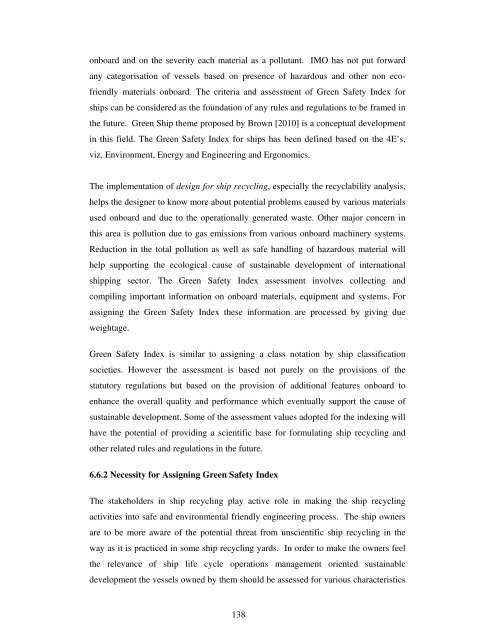Development of Best Practices for Ship Recycling Processes
Development of Best Practices for Ship Recycling Processes
Development of Best Practices for Ship Recycling Processes
You also want an ePaper? Increase the reach of your titles
YUMPU automatically turns print PDFs into web optimized ePapers that Google loves.
onboard and on the severity each material as a pollutant. IMO has not put <strong>for</strong>ward<br />
any categorisation <strong>of</strong> vessels based on presence <strong>of</strong> hazardous and other non eco-<br />
friendly materials onboard. The criteria and assessment <strong>of</strong> Green Safety Index <strong>for</strong><br />
ships can be considered as the foundation <strong>of</strong> any rules and regulations to be framed in<br />
the future. Green <strong>Ship</strong> theme proposed by Brown [2010] is a conceptual development<br />
in this field. The Green Safety Index <strong>for</strong> ships has been defined based on the 4E’s,<br />
viz, Environment, Energy and Engineering and Ergonomics.<br />
The implementation <strong>of</strong> design <strong>for</strong> ship recycling, especially the recyclability analysis,<br />
helps the designer to know more about potential problems caused by various materials<br />
used onboard and due to the operationally generated waste. Other major concern in<br />
this area is pollution due to gas emissions from various onboard machinery systems.<br />
Reduction in the total pollution as well as safe handling <strong>of</strong> hazardous material will<br />
help supporting the ecological cause <strong>of</strong> sustainable development <strong>of</strong> international<br />
shipping sector. The Green Safety Index assessment involves collecting and<br />
compiling important in<strong>for</strong>mation on onboard materials, equipment and systems. For<br />
assigning the Green Safety Index these in<strong>for</strong>mation are processed by giving due<br />
weightage.<br />
Green Safety Index is similar to assigning a class notation by ship classification<br />
societies. However the assessment is based not purely on the provisions <strong>of</strong> the<br />
statutory regulations but based on the provision <strong>of</strong> additional features onboard to<br />
enhance the overall quality and per<strong>for</strong>mance which eventually support the cause <strong>of</strong><br />
sustainable development. Some <strong>of</strong> the assessment values adopted <strong>for</strong> the indexing will<br />
have the potential <strong>of</strong> providing a scientific base <strong>for</strong> <strong>for</strong>mulating ship recycling and<br />
other related rules and regulations in the future.<br />
6.6.2 Necessity <strong>for</strong> Assigning Green Safety Index<br />
The stakeholders in ship recycling play active role in making the ship recycling<br />
activities into safe and environmental friendly engineering process. The ship owners<br />
are to be more aware <strong>of</strong> the potential threat from unscientific ship recycling in the<br />
way as it is practiced in some ship recycling yards. In order to make the owners feel<br />
the relevance <strong>of</strong> ship life cycle operations management oriented sustainable<br />
development the vessels owned by them should be assessed <strong>for</strong> various characteristics<br />
138
















